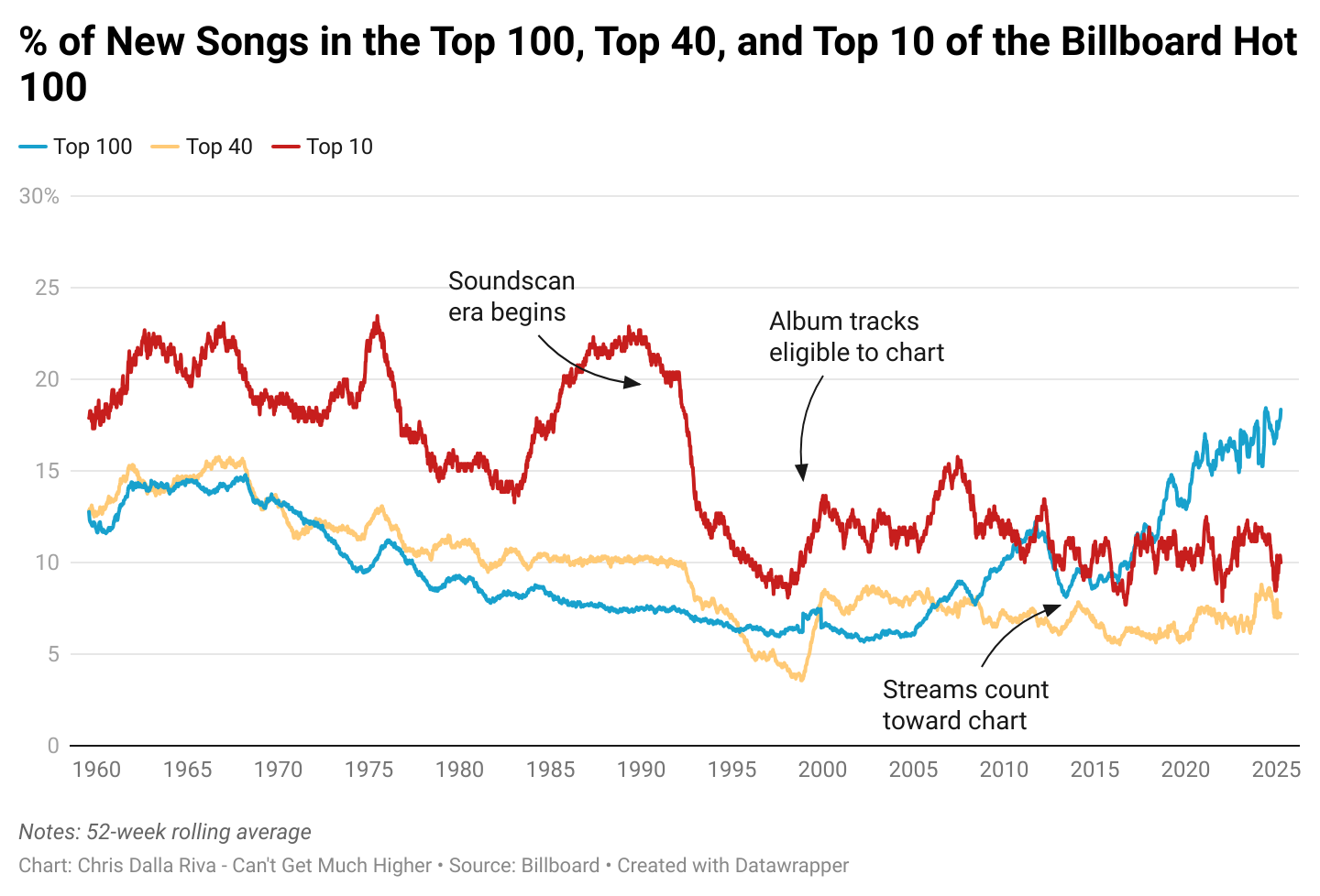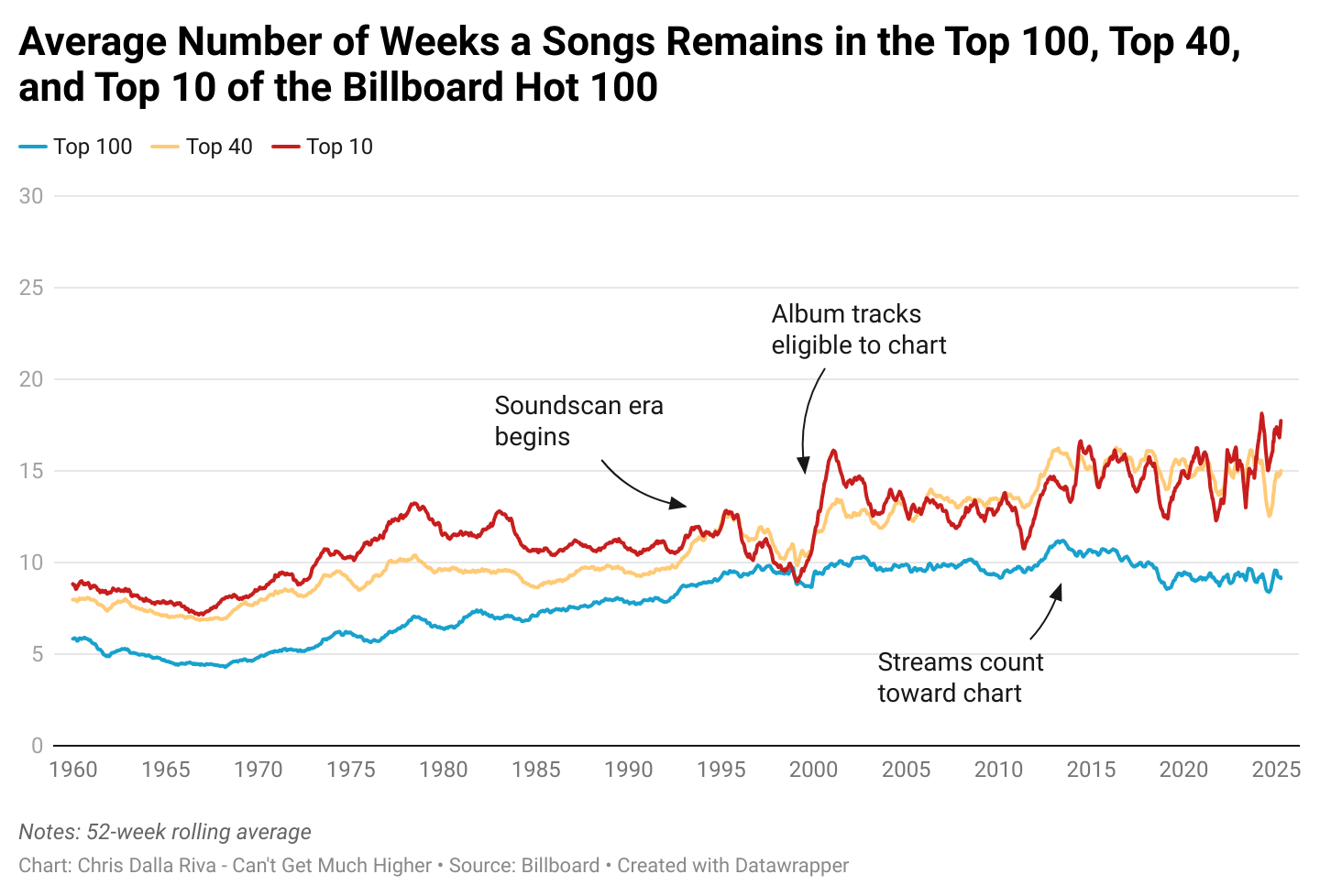Has Pop Music Become Stagnant?
Kind of yes but also no
We’re four months away from the release of my debut book, Uncharted Territory: What Numbers Tell Us about the Biggest Hit Songs and Ourselves, and I couldn’t be more excited. Here is what Evan Bogart had to say about it. Bogart not only runs Seeker Music but has written many hit songs, including Rihanna’s chart-topping “S.O.S.”
This book shines a light on the choices, patterns, and instincts behind the hits we love and the songs we write. It reminds me why I fell in love with songwriting.
If you want to see what Bogart is talking about, consider pre-ordering a copy. Also, note that this link should work for almost any country. It was brought to my attention that people outside the US were previously having trouble ordering. If you still have issues, just reach out.
Has Pop Music Become Stagnant?
By Chris Dalla Riva
Once a month, I answer questions that readers send into me. These questions vary greatly. Some are about specific songs. Others require me to speculate on trends. But one question that I answered earlier this month has continued to bang around inside my head:
Since some songs seem to be spending a year or more in the Top 40 these days, do you think Billboard is doing a disservice with its current methodology to determine its Hot 100? Shouldn't they cap songs at a certain number of weeks on the chart and allow other songs/artists to have a chance at some time in the sun? - Dan
When I first answered this question, I agreed with Dan. If you look at the top ten songs on the Hot 100 this week, the median song has been on the charts for 22.5 weeks. The longest running song — Teddy Swims’ “Lose Control” — has been there for 99. That song came out two years ago. Shouldn’t people be listening to something new?
As time has marched on, I’ve realized that my answer to Dan wasn’t up to snuff. This is a newsletter about music and data. My answer had music. But it didn’t have much data. So, I decided to grab the data. It not only forced me to revise how I answered Dan’s question, but it forced me to rethink how musical stardom works these days.
In summary, I grabbed the entire history of the Billboard Hot 100. I’m quite familiar with this data. (It’s what I used to write my book.) I then looked at the percentage of new songs in the top 10, top 40, and top 100 in each week. For example, if 20% of songs in the top 40 are new, it means that 8 songs (i.e., 40 x 20%) were not in the top 40 last week. When you calculate this rate for the entire history of the Hot 100, you see some interesting trends.
In 1960, 12% of songs on the Hot 100 were new within your average week. Similarly, 13% were new in the top 40, and 18% were new in the top 10. In 2025, things have shifted. 18% of songs on the Hot 100 are new within your average week. Similarly, 7% are new in the top 40, and 10% are new in the top 10. What does this mean?
In short, as compared to decades ago, songs within the top 10 and top 40 change less frequently while songs outside the top 40 change over more frequently. You can see a similar related phenomenon when looking at the number of weeks song spend in various places on the charts.
In 1960, your average song in the Hot 100 stayed on the chart for 6 weeks. Similarly, your average song that made the top 40 stayed there for 8 weeks, and your average song to make the top 10 stayed there for 9 weeks. In 2025, your average song stays in the Hot 100 for 9 weeks, the top 40 for 15 weeks, and the top 10 for 18 weeks. These are big changes. For example, the average stay in the top 10 is up 100%. Why? To understand, we need to dig into a few notes I’ve added to these charts.
What’s Changed about the Billboard Charts?
From the foundation of the Hot 100 through 1990, the charts were compiled by surveying record stores, often via phone calls. This system was not only imprecise but subject to outright fraud. That’s not to say that the charts were completely made up in that period. If you had a number one record, your song was certainly popular. Was it truly more popular than the number two song? Impossible to say.
This all changed in 1991 when Billboard instituted SoundScan. Rather than surveying record stores over the phone, SoundScan tabulated the chart by getting actual point-of-sale data from a sample of record stores. Overnight the charts changed dramatically.
Keep reading with a 7-day free trial
Subscribe to Can't Get Much Higher to keep reading this post and get 7 days of free access to the full post archives.




